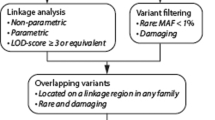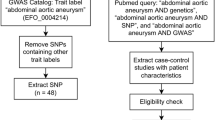Abstract
Genetic factors are known to have an important role in intracranial aneurysm (IA) pathogenesis. The purpose of this study is to identify single-nucleotide polymorphisms (SNPs) that are associated with IA in Japanese population. A total of 2050 IA patients and 1835 controls recruited in Biobank Japan, The University of Tokyo were used in this study. In all, 45 SNPs in 24 genes encoding proteins, which have been considered to be possible risk factors to IA pathogenesis, were genotyped using multiplex PCR-invader assay. Association analysis was evaluated by logistic regression analysis before and after adjustment of age, smoking and hypertension status. This case–control association study revealed a SNP, rs6460071 located on LIMK1 gene (P=0.00069) to be significantly associated with increased risk of IA. In addition, two SNPs, rs243847 (P=0.00086) and rs243865 (P=0.00090), on matrix metallopeptidase 2 (MMP2) gene and one SNP rs1799724 (P=0.0026) on tumor necrosis factor-α (TNF-α) gene, are marginally associated with IA in male- and female-specific manner, respectively. In conclusion, a large-scale case–control association study was conducted to verify genetic variations associated with IA in Japanese population. This study gave insights on the importance of stratified analysis between genders, and suggested that the underlying mechanism of IA pathogenesis might differ between females and males.
Similar content being viewed by others
Log in or create a free account to read this content
Gain free access to this article, as well as selected content from this journal and more on nature.com
or
References
Inagawa, T. Trends in surgical and management outcomes in patients with aneurysmal subarachnoid hemorrhage in Izumo city, Japan, between 1980–1989 and 1990–1998. Cerebrovasc. Dis. 19, 39–48 (2005).
Morita, A., Fujiwara, S., Hashi, K., Ohtsu, H. & Kirino, T. Risk of rupture associated with intact cerebral aneurysms in the Japanese population: a systematic review of the literature from Japan. J. Neurosurg. 102, 601–606 (2005).
Kissela, B. M., Sauerbeck, L., Woo, D., Khoury, J., Carrozzella, J., Pancioli, A. et al. Subarachnoid hemorrhage: a preventable disease with a heritable component. Stroke 33, 1321–1326 (2002).
Teunissen, L. L., Rinkel, G. J., Algra, A. & van Gijn, J. Risk factors for subarachnoid hemorrhage: a systematic review. Stroke 27, 544–549 (1996).
Connolly, E. S. Jr, Choudhri, T. F., Mack, W. J., Mocco, J., Spinks, T. J., Slosberg, J. et al. Influence of smoking, hypertension, and sex on the phenotypic expression of familial intracranial aneurysms in siblings. Neurosurgery 48, 64–68 (2001).
Ronkainen, A., Miettinen, H., Karkola, K., Papinaho, S., Vanninen, R., Puranen, M. et al. Risk of harboring an unruptured intracranial aneurysm. Stroke 29, 359–362 (1998).
Brown, R. D. Jr, Huston, J., Hornung, R., Foroud, T., Kallmes, D. F., Kleindorfer, D. et al. Screening for brain aneurysm in the Familial Intracranial Aneurysm study: frequency and predictors of lesion detection. J. Neurosurg. 108, 1132–1138 (2008).
Okamoto, K., Horisawa, R., Kawamura, T., Asai, A., Ogino, M., Takagi, T. et al. Family history and risk of subarachnoid hemorrhage: a case-control study in Nagoya, Japan. Stroke 34, 422–426 (2003).
Broderick, J. P., Sauerbeck, L. R., Foroud, T., Huston, J. III, Pankratz, N., Meissner, I. et al. The Familial Intracranial Aneurysm (FIA) study protocol. BMC Med. Genet. 6, 17 (2005).
Chapman, A. B., Rubinstein, D., Hughes, R., Stears, J. C., Earnest, M. P., Johnson, A. M. et al. Intracranial aneurysms in autosomal dominant polycystic kidney disease. N. Engl. J. Med. 327, 916–920 (1992).
Edwards, A. & Taylor, G. W. Ehlers-Danlos syndrome with vertebral artery aneurysm. Proc. R. Soc. Med. 62, 734–735 (1969).
Peck, G., Smeeth, L., Whittaker, J., Casas, J. P., Hingorani, A. & Sharma, P. The genetics of primary haemorrhagic stroke, subarachnoid haemorrhage and ruptured intracranial aneurysms in adults. PLoS One 3, e3691 (2008).
Zhang, J. & Claterbuck, R. E. Molecular genetics of human intracranial aneurysms. Int. J. Stroke 3, 272–287 (2008).
Ruigrok, Y. M., Rinkel, G. J. & Wijmenga, C. Genetics of intracranial aneurysms. Lancet Neurol. 4, 179–189 (2005).
Nahed, B. V., Bydon, M., Ozturk, A. K., Bilguvar, K., Bayrakli, F. & Gunel, M. Genetics of intracranial aneurysms. Neurosurgery 60, 213–225 (2007).
McColgan, P., Thant, K. Z. & Sharma, P. The genetics of sporadic ruptured and unruptured intracranial aneurysms: a genetic meta-analysis of 8 genes and 13 polymorphisms in approximately 20 000 individuals. J. Neurosurg. 112, 714–721 (2010).
Bilguvar, K., Yasuno, K., Niemela, M., Ruigrok, Y. M., von Und. Zu. Fraunberg, M., van Duijn, C. M. et al. Susceptibility loci for intracranial aneurysm in European and Japanese populations. Nat. Genet. 40, 1472–1477 (2008).
Yasuno, K., Bilguvar, K., Bijlenga, P., Low, S. K., Krischek, B., Auburger, G. et al. Genome-wide association study of intracranial aneurysm identifies three new risk loci. Nat. Genet. 42, 420–425 (2010).
Hashikata, H., Liu, W., Inoue, K., Mineharu, Y., Yamada, S., Nanayakkara, S. et al. Confirmation of an association of single-nucleotide polymorphism rs1333040 on 9p21 with familial and sporadic intracranial aneurysms in Japanese patients. Stroke 41, 1138–1144 (2010).
Deka, R., Koller, D. L., Lai, D., Indugula, S. R., Sun, G., Woo, D. et al. The relationship between smoking and replicated sequence variants on chromosomes 8 and 9 with familial intracranial aneurysm. Stroke 41, 1132–1137 (2010).
Ohnishi, Y., Tanaka, T., Ozaki, K., Yamada, R., Suzuki, H. & Nakamura, Y. A high-throughput SNP typing system for genome-wide association studies. J. Hum. Genet. 46, 471–477 (2001).
Onda, H., Kasuya, H., Yoneyama, T., Takakura, K., Hori, T., Takeda, J. et al. Genomewide-linkage and haplotype-association studies map intracranial aneurysm to chromosome 7q11. Am. J. Hum. Genet. 69, 804–819 (2001).
Farnham, J., Camp, N., Neuhausen, S., Tsuruda, J., Parker, D., MacDonald, J. et al. Confirmation of chromosome 7q11 locus for predisposition to intracranial aneurysm. Hum. Genet. 114, 250–255 (2004).
Akagawa, H., Tajima, A., Sakamoto, Y., Krischek, B., Yoneyama, T., Kasuya, H. et al. A haplotype spanning two genes, ELN and LIMK1, decreases their transcripts and confers susceptibility to intracranial aneurysms. Hum. Mol. Genet. 15, 1722–1734 (2006).
Mineharu, Y., Inoue, K., Inoue, S., Yamada, S., Nozaki, K., Takenaka, K. et al. Association analysis of common variants of ELN, NOS2A, APOE and ACE2 to intracranial aneurysm. Stroke 37, 1189–1194 (2006).
Berthelemy-Okazaki, N., Zhao, Y., Yang, Z., Camp, N. J., Farnham, J., Parker, D. et al. Examination of ELN as a candidate gene in the Utah intracranial aneurysm pedigrees. Stroke 36, 1283–1284 (2005).
Longstreth, W., Nelson, L., Koepsell, T. & van Belle, G. Subarachnoid hemorrhage and hormonal factors in women. A population-based case-control study. Ann. Intern. Med. 121, 168–173 (1994).
Harrod, C., Batjer, H. & Bendok, B. Deficiencies in estrogen-mediated regulation of cerebrovascular homeostasis may contribute to an increased risk of cerebral aneurysm pathogenesis and rupture in menopausal and postmenopausal women. Med. Hypotheses 66, 736–756 (2006).
Galis, Z. & Khatri, J. Matrix metalloproteinases in vascular remodeling and atherogenesis: the good, the bad, and the ugly. Circ. Res. 90, 251–262 (2002).
Bruno, G., Todor, R., Lewis, I. & Chyatte, D. Vascular extracellular matrix remodeling in cerebral aneurysms. J. Neurosurg. 89, 431–440 (1998).
Todor, D., Lewis, I., Bruno, G. & Chyatte, D. Identification of a serum gelatinase associated with the occurrence of cerebral aneurysms as pro-matrix metalloproteinase-2. Stroke 29, 1580–1583 (1998).
Woodrum, D., Ford, J., Cho, B., Hannawa, K., Stanley, J., Henke, P. et al. Differential effect of 17-beta-estradiol on smooth muscle cell and aortic explant MMP2. J. Surg. Res. 155, 48–53 (2009).
Jayaraman, T., Berenstein, V., Li, X., Mayer, J., Silane, M., Shin, Y. et al. Tumor necrosis factor alpha is a key modulator of inflammation in cerebral aneurysms. Neurosurgery 57, 558–564 (2005).
Huang, H., Thuita, L., Strickland, P., Hoffman, S., Comstock, G. & Helzlsouer, K. Frequencies of single nucleotide polymorphisms in genes regulating inflammatory responses in a community-based population. BMC Genet. 8, 7 (2007).
Jayaraman, T., Paget, A., Shin, Y. S., Li, X., Mayer, J., Chaudhry, H. et al. TNF-alpha-mediated inflammation in cerebral aneurysms: a potential link to growth and rupture. Vasc. Health. Risk. Manag. 4, 805–817 (2008).
Puder, J., Freda, P., Goland, R. & Wardlaw, S. Estrogen modulates the hypothalamic-pituitary-adrenal and inflammatory cytokine responses to endotoxin in women. J. Clin. Endocrinol. Metab. 86, 2403–2408 (2001).
Srivastava, S., Weitzmann, M., Cenci, S., Ross, F., Adler, S. & Pacifici, R. Estrogen decreases TNF gene expression by blocking JNK activity and the resulting production of c-Jun and JunD. J. Clin. Invest. 104, 503–513 (1999).
Xing, D., Feng, W., Miller, A., Weathington, N., Chen, Y., Novak, L. et al. Estrogen modulates TNF-alpha-induced inflammatory responses in rat aortic smooth muscle cells through estrogen receptor-beta activation. Am. J. Physiol. Heart Circ. Physiol. 292, 2607–2612 (2007).
Prather, A., Carroll, J., Fury, J., McDade, K., Ross, D. & Marsland, A. Gender differences in stimulated cytokine production following acute psychological stress. Brain Behav. Immun. 23, 622–628 (2009).
Kono, H., Wheeler, M., Rusyn, I., Lin, M., Seabra, V., Rivera, C. et al. Gender differences in early alcohol-induced liver injury: role of CD14, NF-kappaB, and TNF-alpha. Am. J. Physiol. Gastrointest. Liver Physiol. 278, 652–661 (2000).
Higuchi, T., Seki, N., Kamizono, S., Yamada, A., Kimura, A., Kato, H. et al. Polymorphism of the 5′-flanking region of the human tumor necrosis factor (TNF)-alpha gene in Japanese. Tissue Antigens 51, 605–612 (1998).
Acknowledgements
We express our heartfelt gratitude to all the patients who participate in this study. Our thankfulness also goes to the member of The Rotary Club of Osaka-Midosuji District 2660 Rotary International in Japan for making this study possible. We would like to express our gratefulness to the staff from Biobank Japan for their outstanding assistance. This work was conducted as a part of Biobank Japan Project that was supported by the Ministry of Education, Culture, Sports, Sciences and Technology from the Japanese Government. In addition, this work is performed in collaboration with Center of Genomic Medicine, The Institute of Physical and Chemical Research (RIKEN).
Author information
Authors and Affiliations
Corresponding author
Additional information
Supplementary Information accompanies the paper on Journal of Human Genetics website
Supplementary information
Rights and permissions
About this article
Cite this article
Low, SK., Zembutsu, H., Takahashi, A. et al. Impact of LIMK1, MMP2 and TNF-α variations for intracranial aneurysm in Japanese population. J Hum Genet 56, 211–216 (2011). https://doi.org/10.1038/jhg.2010.169
Received:
Revised:
Accepted:
Published:
Issue date:
DOI: https://doi.org/10.1038/jhg.2010.169
Keywords
This article is cited by
-
Methylation of Phospholipase A2 Group VII Gene Is Associated with Brain Arteriovenous Malformations in Han Chinese Populations
Journal of Molecular Neuroscience (2020)
-
Intracranial Aneurysms: Pathology, Genetics, and Molecular Mechanisms
NeuroMolecular Medicine (2019)
-
Genetic Risk Factors for Intracranial Aneurysm in the Kazakh Population
Journal of Molecular Neuroscience (2018)
-
Association of TNF-α-3959T/C Gene Polymorphisms in the Chinese Population with Intracranial Aneurysms
Journal of Molecular Neuroscience (2017)
-
Critical role of TNF-alpha-TNFR1 signaling in intracranial aneurysm formation
Acta Neuropathologica Communications (2014)



